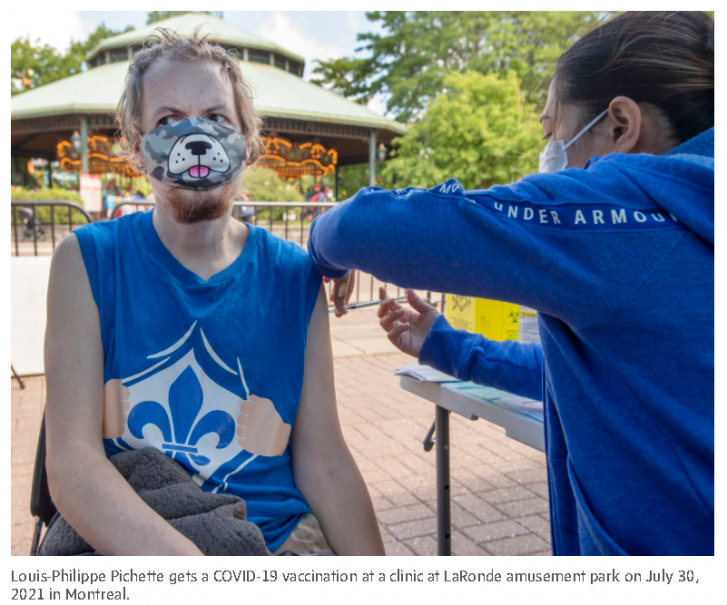Let’s be crystal clear about one thing from the outset: Vaccinated people are not as likely to get and spread the coronavirus as unvaccinated people.
Not even remotely so.
What is true is that in the rare instance someone has a breakthrough infection, they can spread the virus as readily. That is very different. And it’s leaving the false impression that COVID-19 vaccines don’t work.
In fact, vaccines are working remarkably well, even against the new curveballs thrown at them.
Initially, studies showed the COVID-19 vaccines to be up to 95 per cent effective at preventing symptomatic disease.

In the real world, that number – not unexpectedly – dropped a bit, to about 89 per cent against what we now call the Alpha variant.
Against the more transmissible Delta, effectiveness is still an impressive 79 per cent, according to figures from Public Health England, which does some of the world’s most extensive post-market surveillance.
Vaccines are not perfect. Nobody claimed they would be.
You can, in rare instances, still be infected by the coronavirus if you have had two shots. You can, theoretically, infect others.
But, again, we have to keep these unusual occurrences in perspective.
The reality is that, in the vast majority of cases, unvaccinated people are infecting unvaccinated people. Sometimes they are infecting vaccinated people too.
And, yes, vaccinated people can infect unvaccinated people. It’s not clear how likely that is.
As for vaccinated people infecting other vaccinated people? That’s about as likely as spotting a white moose.
What we need to understand a little better is why these breakthrough infections are occurring. (They are called “breakthrough” because they break through the protection vaccines provide.)
Behaviour certainly matters. If you are in a crowd with a lot of infected people, the odds are worse. Dose matters too: If you interact with someone with a really high viral load, that also increases your risk. So does the Delta variant, which is more infectious.
Still, we should not be unduly alarmed by research that shows, for example, that vaccinated people have as much virus in their nose as unvaccinated ones. We have all kinds of bugs up our nose all the time; it’s a key part of our immune system. That doesn’t indicate infectiousness or danger.
We know that when vaccinated people do get infected, they are less likely to develop symptoms, be hospitalized or die.
Don’t be duped by the “news” that infections and hospitalizations are up among the vaccinated. Of course they are. A lot of people are getting vaccinated. But, relatively, way fewer vaccinated people are ending up sick or in hospital and, here, relativity matters.
The pandemic has become a pandemic of the unvaccinated.
Recent Ontario figures tell this story eloquently. Between June 12 and July 21, the unvaccinated made up 95.7 per cent of new COVID-19 cases, 97.4 per cent of hospitalizations, 99.5 per cent of intensive care admissions, and 95.8 per cent of deaths. (These numbers come from COVID-19 data cruncher extraordinaire, Dr. Jennifer Kwan.)
Data out of the U.S. about breakthrough infections are also quite telling. Between Jan. 1 and April 30, there were 10,262 breakthrough infections recorded among 11.8 million infections.
That’s the story we have to retain: If you are fully vaccinated, you have a minimal chance of getting infected, getting sick or dying of COVID-19.
That’s why there is such a push on for vaccine mandates (making vaccination mandatory for certain workers, such as nurses and personal support workers), vaccine certificates (proof of vaccination that allows you to visit public spaces including restaurants and sports venues) and vaccine passports (documentation of immunization that allows you to travel to other countries).
So if vaccines work so well, and a lot of people are now vaccinated (about 23 million Canadians have both shots), why are public-health officials reluctant to lift restrictions and, in some cases, still urging vaccinated people to wear masks?
It’s not because the vaccines don’t work. It’s because we want to protect the vulnerable, especially those who can’t yet get the shot, such as children, and those who are immunocompromised.
The real breakthrough we need to concern ourselves with is convincing a sufficiently large percentage of the population – 80 per cent or more – to get their shots so that we can virtually stop the coronavirus from spreading in our communities.
The six million Canadians who have still not got their shots need to be our focus, not the small number of vaccinated ones who could theoretically spread the virus.
Article From: Globe and Mail
Author: ANDRÉ PICARD

